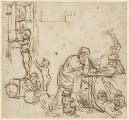It hasn't gone too far; it went too far maybe ten years ago. If there are art institutions where curators and directors are identified only by their names, roles and/or specialities I don't manage to come across them. As a matter of journalistic self-interest I never cite the donors names--they take up too many words and even without that I never feel I am given enough space to get across what I'd like to say. Just stumbling on such roll calls makes me start to growl. .

In the spirit of the holidays (and owing to the perpetual drowsiness that is the gift of these darkest days of the year), I feel it would be inexcusably nasty to give examples. As soon as I wrote that I had a change of heart. (To left is growling under the influence of Christmas and the winter solstice.) So I'll name a few names just for flavor. John Guy, when he traveled from the Victoria & Albert Museum in London to the Metropolitan Museum of Art in New York became Florence and Herbert Irving Curator of the Arts of South and Southeast Asian Art, Department of Asian Art. Who are Florence and Herbert Irving? Even having attached their names to John Guy for whom I have a lot of respect did not prod me to make the tiny effort necessary to Google. So what's the point. And then there is Malcolm Rogers, the Ann and Graham Gund Director of Boston's Museum of Fine Arts.Please tell me: Isn't having the title Director of a great museum enough? And sorry Ann and Graham I'm not Googling you either. It's only personal, generically.
Great that so many people give money to staff museums, build more attractive galleries, add lecture theaters and so forth. And it is easy to understand why the Trustees--and Directors--go along with donors' demands to have name tags in big letters attached to their largess so the public notices. Well folks, here's the news: We don't care about the names of donors only the results. So grow up and stop making such demands. It looks pushy, self important even silly. There have got to be better ways to honor largess. It is time to stop clogging up the titles of gifted contributors to our education and pleasure with rich peoples' names.

 Everything about the this ink drawing surprised me except for how good it is. Adam Elsheimer (1578--1610) is known for his paintings on copper--not canvas or panel. They are usually small and often night scenes like the Flight into Egypt below. Always they are arresting; walking through a gallery and coming on one of these paintings, it is as if the museum's wall had suddenly opened up and I am looking directly into luminous, poetic Elsheimer's 's imagination. I am drawn deeper in and I like every minute of it. The drawing of "The Artist Despairing of his Poverty," took me somewhere less alluring but more compelling if also disturbing.
Everything about the this ink drawing surprised me except for how good it is. Adam Elsheimer (1578--1610) is known for his paintings on copper--not canvas or panel. They are usually small and often night scenes like the Flight into Egypt below. Always they are arresting; walking through a gallery and coming on one of these paintings, it is as if the museum's wall had suddenly opened up and I am looking directly into luminous, poetic Elsheimer's 's imagination. I am drawn deeper in and I like every minute of it. The drawing of "The Artist Despairing of his Poverty," took me somewhere less alluring but more compelling if also disturbing.